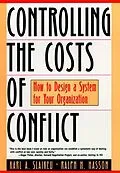Written for non-experts in jargon-free language, this work shows how to create systems within organizations that preempt the monetary, strategic, and emotional costs associated with on-the-job conflict. Its clear and simple approach translates advanced concepts into practical how-tos and provides readers with four guiding principles they can follow to create conflict control systems of their own. Amply illustrated with real-world examples, it details the policies, procedures, and practices that make for successful control systems and tells precisely how to implement them.
Autorentext
KARL A. SLAIKEU is president of Chorda Conflict Management, a consulting and training company that specializes in conflict management systems. He has taught in the psychology departments of the University of South Carolina at Columbia and the University of Texas at Austin, and is the author of When Push Comes to Shove: A Practical Guide to Mediating Disputes (Jossey-Bass, 1996). RALPH H. HASSON is vice president of Chorda Conflict Management. He also serves in the Graduate School of Business at the University of Texas at Austin, where he teaches negotiation.
Klappentext
In an increasingly collaborative business environment, continued success often depends on the ability of individuals, teams, and organizations with mutual interests to work smoothly together. But as any manager knows, things do not always go as planned.
When the inevitable conflict arises, many companies resort to power plays, rush to litigation, or simply choose to ignore the problem-options that can cost a company dearly in more ways than one. Those costs can often be avoided, however, with the establishment of systems that promote collaboration and stop disagreements from becoming expensive disputes. Here, two experts offer four guiding principles for doing just that.
Written for non-experts in jargon-free language, Controlling the Costs of Conflict shows readers how to build the kinds of policies, procedures, and practices that can cut up to 80 percent of related legal expenses, slow turnover, strengthen long-term business relationships, reduce stress, and promote the success of an organization's mission. Its clear and simple approach translates advanced concepts into practical how-tos, illustrating key points with real-world examples.
From choosing the best resolution option to early intervention to fostering collaborative strength, the guidelines found here apply equally to businesses, public agencies, religious institutions, schools, neighborhood associations, even nations. These principles will help organizations diagnose the weaknesses in their existing systems or build from scratch new systems that have the power to reduce the monetary, strategic, and emotional costs of conflict.
Inhalt
Introduction.
The Hidden Culprit of High Costs: Weak Systems.
First Principle: Acknowledge Four Ways to Resolve Conflict.
Defining Four Options.
Weighing Costs and Risks of Each Method.
Choosing an Approach to Conflict Management.
The Preferred Path for Cost Control.
Second Principle: Create Options for Prevention and EarlyIntervention.
A Template for All Organizations.
Applying the Template: Real Stories.
Third Principle: Build Collaborative Strength Through SevenCheckpoints.
Seven Checkpoints.
Clarify Policy.
Define Roles and Responsibilities.
Revise Documents.
Establish Selection Criteria.
Provide Education and Training.
Strengthen Support Systems.
Evaluate the System.
Fourth Principle: Use the Mediation Model to Build Cosensus AmongDecision Makers and Users.
Assumptions About Change.
Phase One: Draft a Blueprint.
Phase Two: Implement the Plan.
Phase Three: Review the System Annually.
Conclusion.
Conclusion: A Vision for Your Organization.
Resource A: Glossary.
Resource B: Ombudsman Code of Ethics and Standard Practices.
Resource C: Skills Courses.
